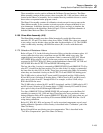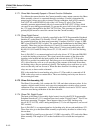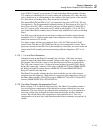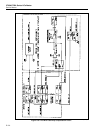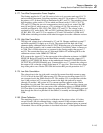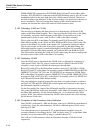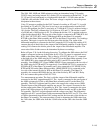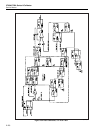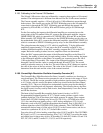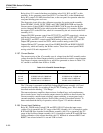
Theory of Operation
Analog Section Detailed Circuit Description
2
2-117
2-181. Calibrating to the External 10 KW Standard
Refer to Figure 2-33 for the following discussion. The first step in ohms calibration is to
compare the 10 kΩ standard against the 10 kΩ value on the Ohms Cal assembly. This is
done by passing a current through both values and measuring the voltage drop across
each. The ratio of the voltages is equal to the ratio of the resistances.
The source of current comes from the 2/5/10V source circuit, which contains U1, Q1,
Q2, Q3 and Z1. The buffered 13V reference voltage from the DAC assembly (A11) is
switched through K9 to a voltage divider made up of resistors in Z1.
To calibrate the 10 kΩ resistance, control lines PB4 and PB5 turn off FETs Q2 and Q3
respectively. In this mode, the output of the divider uses the 15 kΩ and 50 kΩ values to
produce an output of 10V. This voltage is buffered by U1 and Q1. The current from this
source, 10V OUT HI, is sent through K19 to one side of the 10 kΩ resistance in Z5. 10V
SENSE HI is connected to 10V OUT HI by K31A on the Ohms assembly. The other side
of the 10 kΩ resistance in Z5 is connected to OHMS OUT HI by K19. This is routed to
the Ohms Main assembly where is goes through K29, K15 and K1 to INT OUT HI,
which is connected to the OUTPUT HI binding post by relays on the motherboard. From
there it goes through the external 10 kΩ standard and back in through the OUTPUT LO
binding post and over to the Ohms Cal assembly where it connects to S COM through
K24 and K22.
The voltage drops are measured by comparing each voltage to the DAC assembly output
in a differential amplifier circuit made of U2 through U5.
Since the DAC and differential amplifier are referenced to R COM, this line is brought
out through K27, K23 and K25 to INT SENSE LO. This is connected to the SENSE LO
binding post (which is connected to the sense low point of the standard). Line DAC OUT
LO is tied to S COM by relay K31. The high side of the DAC, DAC OUT HI and DAC
SENSE HI, are tied together and connected by K12 to U2, which is the differential
amplifier -input.
The voltage to be measured is connected to U3, which is the differential amplifier
+input. The output of U2 and U3 goes to U4 through gain setting resistors in Z1. These
set the gain of the differential amplifier to 75. The differential amplifier generates a
current through the 1 kΩ (pins 1-2) and 75 kΩ (pins 2-3) resistors in Z1 to R COM. This
current on R COM can cause an error during measurement. Op amp U5, configured as an
inverting amplifier, generates an equal current of opposite polarity through 76 kΩ
resistor R18 to cancel the current from the differential amplifier. The output of U4 goes
through K10 to the RCL line. This line is connected to the DAC assembly, where it goes
through an amplifier to the adc circuit.
The calibration program uses the adc circuit to measure the differential amplifier output
voltage. First the differential amplifier offset voltage is determined. (This offset is
different for each input condition.) Readings are taken to determine each offset voltage
by checking the output of the differential amplifier at equal voltages on the inputs. This
is done by switching K11 to the reset position to connect the differential amplifier +input
and -input together, then measuring the output with the DAC’s adc circuit.
Once the offsets are known, the software determines the calibration voltages by
adjusting the DAC output until the adc reading is the same as the offset. At that point,
the DAC output equals the voltage being measured.
Three readings are required to determine the ratio of the two resistances. For the first
reading, K16 connects the differential amplifier +input to the 10 kΩ resistor in Z5. For
the second reading, K17 connects the +input to the other side of that resistor. Subtracting
the first reading from the second gives the voltage across the internal 10 kΩ. For the
third reading, K1 on the Ohms Cal assembly connects the + input to OHMS SENSE HI.



